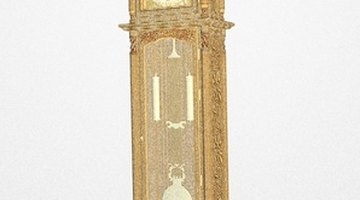How to Replace a Grandfather Clock Suspension Spring
Grandfather clock suspension springs are designed to support the pendulum of the clock while allowing it the necessary freedom of movement it requires to operate properly. Suspension springs are made from a combination of thin strips of tempered steel with brass collars on each end and come in a variety of sizes. Because of their construction of thin steel, suspension springs can be damaged when the pendulum is removed or replaced without proper care being taken. However, grandfather clock suspension springs can be replaced by the clock owner in one hour with a minimum amount of tools.

-
Open the front panel door of the grandfather clock to access clock weights and the pendulum.
-
Stop the pendulum if it is in motion by placing your hand in the path of the pendulum bob while holding a soft cotton cloth. The bob is the large round disc-shaped weight at the lower portion of the pendulum.
-
Remove the weight canisters using a soft cotton cloth. Mark each weight canister as it is removed according to its position as “R” for right side, “M” for middle and “L” for the left side. Place a small piece of masking tape with these marks on the bottom of each canister.
-
Remove the pendulum from the suspension rod by gently lifting it up and forward toward the front of the case. If necessary, open a side panel or look through a side glass panel to observe the pendulum hook and the suspension rod to better understand the method for removal.
-
Access the suspension rod and spring from either the removable side panels of the grandfather clock case or by removing the bonnet (or crown) of the clock case. Bonnets and crowns are lifted off from the case or slid off from the front of the clock.
-
Remove the suspension rod from the suspension spring by lifting the rod up and out from the hook pins that are located on either side of the suspension spring’s lower collar. Allow the rod to rest in the saddle of the anchor arm or crutch as it is referred to on older clocks it passes through after removing it from the spring.
-
Remove the thumbscrew which secures the suspension spring to the suspension post. If necessary, loosen the thumbscrew using combination pliers. Turn in a counterclockwise direction to remove the thumbscrew. If the suspension spring is secured to the post with a wedge pin, remove the pin with needle-nose pliers.
-
Remove the suspension spring from the suspension post.
-
Install the new suspension spring into the suspension post and line up the screw or pin holes of the suspension spring collar with the post holes by inserting a round toothpick through the post and through the spring collar.
-
Install the suspension spring thumbscrew or pin into the suspension post.
-
Install the suspension rod onto the hook pins of the suspension spring collar by raising it up over the hook pins and then down until it is fully seated. Take care not to apply too much pressure on the suspension spring.
-
Replace the bonnet or crown if it was necessary to remove them for access.
-
Install the pendulum by raising the pendulum rod hook over the pins of the suspension rod and gently allow it to seat. Perform this task with care to avoid damaging the new suspension spring. Use the cotton cloth to avoid contact with any brass portion of the pendulum.
-
Install the weight canisters according to the position in which they were removed. “R” goes on the right side, “M” in the middle and “L” on the left side. Handle all brass with a soft cotton cloth.
-
Set the pendulum into motion by moving the pendulum bob to either side of the grandfather clock case and releasing it.
-
Close all panel doors on the grandfather clock case.
References
Tips
- Be sure that the replacement spring is exactly the same size as the old spring. Compare it on a template if it is to be ordered online, or take it along to your local clock shop for comparison.
Warnings
- Do not in any way twist or distort the new spring when installing the pendulum.
Writer Bio
Max Stout began writing in 2000 and started focusing primarily on non-fiction articles in 2008. Now retired, Stout writes technical articles with a focus on home improvement and maintenance. Previously, he has worked in the vocational trades such as automotive, home construction, residential plumbing and electric, and industrial wire and cable. Max also earned a degree of biblical metaphysician from Trinity Seminars Ministry Academy.
Photo Credits
- grandfather clock image by Paul Moore from Fotolia.com
More Articles



